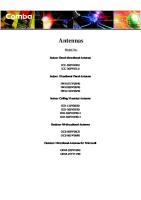Antenna Questions
Short questions: 1. 2. 3. 4. 5. 6. 7. 8. 9. 10. 11. 12. 13. 14. 15. 16. Antennas Radiation resistance Quality factor Ha
Views 232 Downloads 4 File size 125KB
Recommend stories
- Author / Uploaded
- Sadiqur Rahaman Sumon
Citation preview
Short questions: 1. 2. 3. 4. 5. 6. 7. 8. 9. 10. 11. 12. 13. 14. 15. 16.
Antennas Radiation resistance Quality factor Half-power beamwidth Far-field of an antenna Equivalent circuit Reciprocity Polarization loss factor Omnidirectional pattern Radar cross section Radiation efficiency Polarization Friis transmission equation and its importance Input impedance Field regions of an antenna Vector effective length
An essay question: Linear wire antennas, their advantages and disadvantages, characteristics and operation principles. An essay question: Microstrip antennas, their advantages and disadvantages, characteristics and operation principles. An essay question: Microstrip antennas, their characteristics and operation principles.
Explain parameters (5 Pcs) which affect the antenna array radiation pattern. b) Draw the structure, dimensions and radiation pattern for a two element antenna array when the gain is maximized i) in the broadside and ii) along the axis of array (end-fire). Assume omnidirectional antenna elements.
1> A hypothetical isotropic antenna is radiating in free-space. At a distance of 100 m from the antenna, the total electric field (Eθ) is measured to be 5 V/m. Find (a) power density (Wrad) and (b) power radiated (Prad).
2> The complex input impedance of a
λ/2 dipole antenna, including the loss resistance of 2 Ω , is 75+j42.5 Ω .
The antenna is connected to a generator whose output peak voltage is 3 V and internal impedance equals 50 Ω. Draw the equivalent circuit for the described arrangement. Find a) the power radiated by the antenna, b) the reflection efficiency of the antenna, c) the radiation efficiency of the antenna, and d) the total (overall) efficiency of the antenna. (|)
3> Let’s consider an electrically small dipole ( λ/50
Three isotropic sources, with spacing d between them, are placed along the z-axis. The excitation coefficient of each outside element is I1 = I3 = 1 while that of the centre element is I2 = 2. For a spacing of d = λ/4 between the elements, a) draw a picture of the array, b) find the array factor, and c) angles (in degrees) where the maxima of the pattern occur ( 00≤θ≤1800), d) sketch the pattern for each element, for array factor and for total field pattern. 5> The input reactance of an infinitesimal linear dipole of length l= λ/60 and radius a=λ/200 is given by
X ¿ =−120
ln ( l / 2 a )−1 tan kl/ 2
where k=2π/ λ is the wave number. Assuming the wire of the dipole is copper with a conductivity of 5.7x107 s/m, determine a) the loss resistance, b) the radiation resistance, and c) the radiation efficiency at f=1 GHz.
6> A resonant, lossless half-wavelength dipole antenna, having a directivity of 2.156 dBi, has the input impedance of 73 Ω and is connected to a lossless 50 transmission line. A wave, having the same polarization as the antenna, is incident upon the antenna with a power density of 5 W/m2 at a frequency of 10 MHz. Find the received power available at the end of the transmission line. 7> A uniform array of 3 isotropic antenna elements on the z axis is designed so that its maximum of the array factor is directed broadside. The spacing between the elements is λ/2. For the array factor of the antenna, determine (a) all the angles in degrees where the nulls will occur, (b) all the angles in degrees where all the maxima will occur, and (c) directivity in dBi. 8> Design a rectangular microstrip patch antenna operating at 5 GHz with the dominant TM010 mode. The height and the dielectric constant of the substrate are 3.2 mm and 3.38, respectively. What is antenna’s (a) width, (b) length, and (c) impedance at the resonance frequency and referenced to the edge? In the antenna design you do not need to take into account the mutual conductance between the radiating slots of the patch antenna. 9> A small one-turn circular loop antenna has the loop radius of λ/30 and the wire radius of λ/1000. The operating frequency is 1 MHz. The wire of the loop is made of copper with the conductivity of 5.7x 107 S/m. Assuming the
antenna is radiating in free space, determine the antenna impedance and the radiation efficiency. µ = µ0=4 π x107 H/m. 10> A radiation pattern of an antenna is modeled in such a way that the radiation intensity is uniform over specified directions and is zero elsewhere. Anexample of the pattern is
where B0 is the constant radiation intensity [W/sr]. For this example, (a) derive an equation for the directivity as a function of α and β, and (b) calculate the directivity of the antenna in dBi when α= 5° and β= 45°.
11> Transmitting and receiving antennas, operating at 1GHz with gains of 20 dBi and 15 dBi, respectively, are separated by a distance of 1 km. Find the maximum power delivered to the receiver input when power at the transmit antenna input is 150 W. Transmitting antenna is circularly polarized (either right-or left- hand) and the receiving antenna is linearly polarized.
12> The normalized electric field of a vertical dipole antenna located over perfect conductor (in horizontal plane) follows the equation
The antenna is used as a communication antenna at the VHF band (f = 200 MHz). In order to avoid interference with other simultaneously operating communication systems, it is desired to place a null in the far-field amplitude pattern at an angle of 60° from the vertical. Determine the three smallest physical heights above the perfect conductor at which the antenna can be placed to meet the desired pattern specifications.









